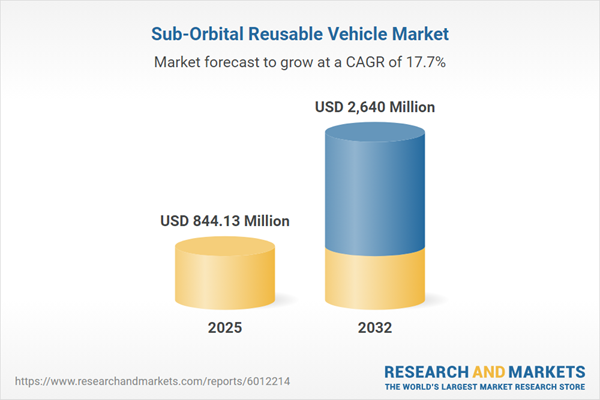Speak directly to the analyst to clarify any post sales queries you may have.
Senior decision-makers in the aerospace industry are realigning strategies to stay ahead as sub-orbital reusable vehicle advancements redefine opportunities in near-space missions. This sector presents streamlined pathways to enhance operational agility, drive organizational efficiency, and fortify competitive positioning within evolving regulatory and commercial environments.
Market Snapshot: Sub-Orbital Reusable Vehicle Market
The global sub-orbital reusable vehicle market continues to accelerate, with a trajectory from USD 716.63 million in 2024 to USD 844.13 million in 2025, reaching USD 2.64 billion by 2032. This expansion translates to a compound annual growth rate (CAGR) of 17.74%.
Innovations in propulsion systems and materials are crucial drivers, enabling organizations to achieve cost reductions and consistently reliable mission execution. Regulatory adjustments further create favorable conditions for established enterprises and newcomers, spurring scalable, modular vehicle development. Public and private collaborations are deepening as research, cargo transportation, crew training, and space tourism reshape sector dynamics. Executive focus remains on modularity and flexibility for sustained adaptability in a marketplace marked by rapidly shifting compliance demands and competitive pressures.Scope & Segmentation
This market research report delivers refined segmentation and actionable intelligence for aerospace organizations looking to shape their standing in the sub-orbital reusable vehicle market:
- Application: Addresses sector needs from crew training and scientific research to defense, educational outreach, and tourism, each demanding tailored operational planning and investment.
- Customer Types: Distinguishes between commercial launch providers, government agencies, and private enterprises, highlighting their varied procurement processes and regulatory expectations.
- Vehicle Types: Covers crewed vehicles that enhance passenger safety and experience, as well as uncrewed platforms developed for flexibility and autonomous performance.
- Propulsion Types: Explores hybrid engines, liquid fuels, and solid fuel technologies, each offering specific reliability, cost, and infrastructure trade-offs for mission suitability.
- Cabin Capacities: Details solutions from single-occupant modules designed for focused use to larger, multi-passenger cabins supporting expanded mission goals and commercial models.
- Regions Covered: Assesses North America, South America, Europe, Middle East & Africa, and Asia-Pacific, noting how regional differences in regulation, investment, and infrastructure recalibrate strategies and risk profiles.
- Companies Analyzed: Provides strategic insights into Blue Origin, Virgin Galactic Holdings, UP Aerospace, Masten Space Systems, Exos Aerospace, Space Perspective Holdings, World View Enterprises, Zero 2 Infinity, Starchaser Industries, and Interorbital Systems to clarify innovation, investment, and partnership trends shaping the market.
Key Takeaways for Senior Leaders
- Integrating advanced propulsion and materials streamlines mission cycles, maximizing responsiveness and operational continuity in rapidly evolving contexts.
- Establishing inter-sector partnerships cultivates expanded mission horizons, improved infrastructure access, and diversified investment streams.
- Emphasizing modular vehicle design supports swift adaptation to new regulatory requirements and evolving safety mandates.
- Prioritizing comprehensive risk management and robust operational planning enhances reliability across research and commercial initiatives.
- Continuous development of the technical workforce and deeper collaboration fuels ongoing product and service improvements.
Tariff Impact and Supply Chain Evolution
Shifting U.S. tariff scenarios are driving aerospace organizations to increase reliance on domestic suppliers and emphasize modular manufacturing approaches. These procurement adjustments aim to stabilize delivery schedules, contain cost fluctuations, and ensure compliance. In response, suppliers are recalibrating supply chain strategies to support evolving regulatory landscapes, strengthening mission assurance across the project lifecycle.
Methodology & Data Sources
This report is based on thorough primary data collection, systematic regulatory monitoring, and meticulous analysis of technical literature. Findings are validated with direct input from industry experts, ensuring usability for senior leaders navigating complex strategic decisions.
Why This Report Matters
- Enables executive teams to optimize resource allocation and build value through strategic partnerships and alliances.
- Delivers granular segmentation and actionable regional analysis, supporting informed decisions on market entry or expansion.
- Equips leadership to recognize demand trends and identify prioritized opportunities within the aerospace value chain.
Conclusion
This report provides senior leaders with strategic insights to accelerate growth, harness competitive advantages, and steer their organizations through the rapid evolution of the sub-orbital reusable vehicle market.
Additional Product Information:
- Purchase of this report includes 1 year online access with quarterly updates.
- This report can be updated on request. Please contact our Customer Experience team using the Ask a Question widget on our website.
Table of Contents
3. Executive Summary
4. Market Overview
7. Cumulative Impact of Artificial Intelligence 2025
Companies Mentioned
The companies profiled in this Sub-Orbital Reusable Vehicle market report include:- Blue Origin, L.L.C.
- Virgin Galactic Holdings, Inc.
- UP Aerospace, Inc.
- Masten Space Systems, Inc.
- Exos Aerospace, Inc.
- Space Perspective Holdings, LLC
- World View Enterprises, Inc.
- Zero 2 Infinity, S.L.
- Starchaser Industries, Ltd.
- Interorbital Systems, Inc.
Table Information
| Report Attribute | Details |
|---|---|
| No. of Pages | 180 |
| Published | November 2025 |
| Forecast Period | 2025 - 2032 |
| Estimated Market Value ( USD | $ 844.13 Million |
| Forecasted Market Value ( USD | $ 2640 Million |
| Compound Annual Growth Rate | 17.7% |
| Regions Covered | Global |
| No. of Companies Mentioned | 11 |









